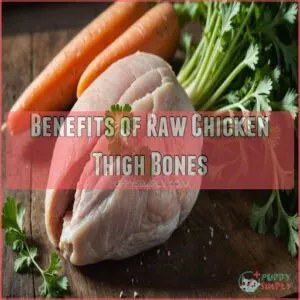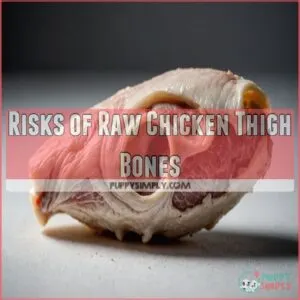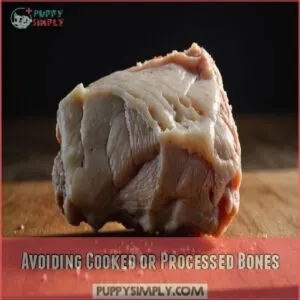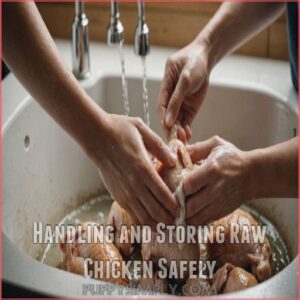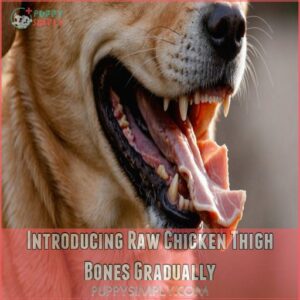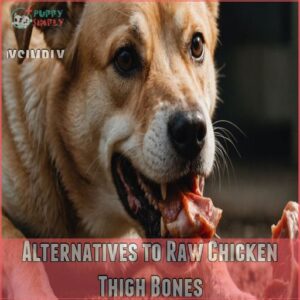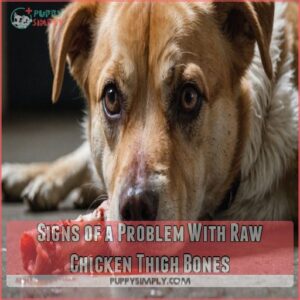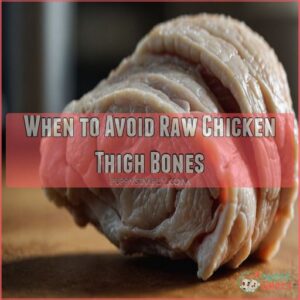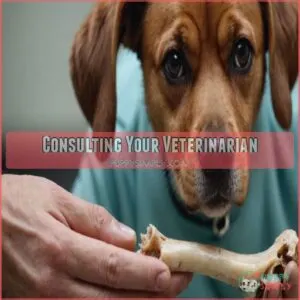This site is supported by our readers. We may earn a commission, at no cost to you, if you purchase through links.
 You might think tossing your pup a raw chicken thigh bone is a tasty treat, but hold your horses!
You might think tossing your pup a raw chicken thigh bone is a tasty treat, but hold your horses!
While dogs can technically eat raw chicken thigh bones, it’s not recommended.
These bones can splinter, potentially causing choking or internal injuries.
Plus, raw chicken carries bacteria like Salmonella, which can make your furry friend sick.
It’s tempting to indulge your dog’s inner wolf, but safety comes first.
That doesn’t mean you can’t give your pooch a bone to chew on – there are safer alternatives that’ll keep their tails wagging.
Curious about what those might be?
Stick around to discover some mouth-watering options that’ll have your dog howling with joy.
Table Of Contents
- Key Takeaways
- Benefits of Raw Chicken Thigh Bones
- Risks of Raw Chicken Thigh Bones
- Choosing The Right Raw Chicken Thigh Bones
- Preparing and Feeding Raw Chicken Thigh Bones
- Alternatives to Raw Chicken Thigh Bones
- Signs of a Problem With Raw Chicken Thigh Bones
- When to Avoid Raw Chicken Thigh Bones
- Consulting Your Veterinarian
- Frequently Asked Questions (FAQs)
- Can dogs eat raw chicken thighs?
- What meat should I never feed my dog if they have dementia?
- Can dogs eat chicken bones?
- Can dogs eat chicken bones without thawing?
- Can dogs eat raw chicken feet?
- Are chicken thighs good for dogs?
- Are raw chicken thigh bones okay for dogs?
- What happens if a dog eats a chicken thigh bone?
- What kind of raw bones can dogs eat?
- Can dogs eat raw boneless chicken thighs?
- How often can I give my dog raw chicken thigh bones?
- Can puppies safely eat raw chicken thigh bones?
- Are there specific breeds that shouldnt eat chicken thigh bones?
- How long can raw chicken thigh bones be stored?
- Can raw chicken thigh bones help with dental issues?
- Conclusion
Key Takeaways
- You shouldn’t give your dog raw chicken thigh bones due to the risks of potential obstruction and tearing in their digestive tract, which can be caused by chicken bone splinters. You shouldn’t give your dog raw chicken thigh bones due to risks of choking and bacterial infections like Salmonella that can make them sick. It’s safer to explore alternative chews.
- Raw chicken thigh bones do offer nutritional benefits like calcium and phosphorus, and they can help clean your dog’s teeth by acting as natural scrapers.
- Always supervise your dog’s bone-chewing sessions to prevent choking hazards and ensure the bones don’t splinter, causing internal injuries.
- Consult your vet for personalized advice on feeding bones, ensuring your dog’s diet is well-balanced and safe.
Benefits of Raw Chicken Thigh Bones
You’ll be surprised by the benefits raw chicken thigh bones can offer your furry friend.
From providing essential nutrients to promoting dental health, these natural chews pack a powerful punch for your dog’s overall well-being.
Provide Essential Nutrients and Minerals
While it might sound like a bone-headed idea, raw chicken thigh bones can be a nutritional powerhouse for your furry friend.
They’re packed with essential nutrients that’ll have your pup wagging their tail in delight.
Here’s what these bony treats bring to the doggy dish:
- Calcium for strong bones
- Phosphorus for energy
- Collagen for joint health
- Vitamin D for nutrient absorption
- B vitamins for metabolism
These lean protein gems offer a natural way to supplement your dog’s diet, giving them the building blocks they need to thrive.
Just remember, moderation is key!
Help Clean Teeth and Promote Dental Health
Raw chicken thigh bones aren’t just nutritious – they’re nature’s toothbrush for your pup!
As your dog gnaws away, the bones act like a natural scraper, removing plaque and tartar buildup.
Similar to best bones for dogs teeth, raw chicken thigh bones provide natural cleaning benefits.
This chewing action stimulates saliva production, which helps neutralize harmful bacteria in their mouth.
It’s like giving your furry friend a mini dental workout, promoting healthier gums and fresher breath.
Just remember, always supervise your dog’s bone-chewing sessions for safety.
Satisfy Natural Chewing Instinct
Beyond dental health, raw chicken thigh bones tap into your dog’s primal instincts.
These natural chews provide a satisfying outlet for their innate urge to gnaw, potentially reducing destructive behaviors around the house.
It’s like giving them a prehistoric chew toy!
Just remember, the bone size should match your pup’s breed to guarantee safe chewing practices.
This simple act can keep your furry friend mentally stimulated and physically content.
Lean Protein Source
Chicken thighs aren’t just chew toys for your pup; they’re a powerhouse of lean protein.
Your dog’s muscles will thank you for this nutrient-dense treat. It’s like giving them a gym membership and a protein shake all in one!
But remember, moderation is key – too much of a good thing can lead to an unbalanced diet.
- Watching your furry friend grow stronger with each bite
- Feeling proud as their coat becomes shinier and healthier
- Knowing you’re providing a natural, species-appropriate snack
Improve Joint Health
You’ve heard about protein, but let’s talk about your pup’s joints.
Raw chicken thigh bones are packed with glucosamine and chondroitin, nature’s joint supplements.
They’re like a doggy gym for jaw muscles, promoting overall muscle development.
The omega fatty acids? They’re joint health superheroes, fighting inflammation.
It’s like giving your furry friend a daily massage from the inside out.
Remember, though, balance is key – pair these bones with a proper exercise routine for great dog health.
Risks of Raw Chicken Thigh Bones
You might think raw chicken thigh bones are a tasty treat for your dog, but they come with some serious risks.
From choking hazards to bacterial infections, these bones can pose unexpected dangers to your furry friend’s health.
Choking or Obstruction if Not Chewed Properly
While raw chicken thigh bones can be a tasty treat, they come with risks.
Your pup’s chewing habits play a key role in safety.
To minimize choking or obstruction hazards:
- Choose bones larger than your dog’s mouth
- Supervise chewing sessions closely
- Remove bones when they become small enough to swallow
- Know your dog’s chewing style
Remember, even careful dogs can gulp down bones unexpectedly.
When offering your dog a treat, be aware of the dangers of rib bones and choose safe alternatives for dogs. Stay vigilant to keep your furry friend safe and sound.
May Contain Bacteria Like Salmonella or Campylobacter
Let’s talk about a hidden danger lurking in those raw chicken thigh bones.
Beyond choking hazards, they might carry uninvited guests: bacteria like Salmonella and Campylobacter.
These microscopic troublemakers can cause quite a stir in your pup’s tummy.
Here’s a quick rundown of what you’re up against:
| Bacteria | Symptoms | Prevention |
|---|---|---|
| Salmonella | Fever, diarrhea | Freeze bones |
| Campylobacter | Vomiting, lethargy | Clean surfaces |
| E. coli | Dehydration, weakness | Handle with care |
Don’t let these scary names put you off entirely.
With proper food safety practices, you can minimize risks and keep your furry friend’s tail wagging.
Possibility of Splintering and Causing Internal Injuries
Raw chicken bones aren’t invincible.
Despite their softness compared to cooked bones, they can still splinter under your dog’s powerful jaws.
These sharp fragments might scratch or puncture your pup’s throat, stomach, or intestines.
It’s like walking on eggshells – one wrong crunch and you’re headed for the vet.
To minimize risks, explore suitable alternatives like raw chicken bone products.
Always supervise your furry friend and choose bones that match their size to minimize these risks.
Allergic Reactions
Beyond the risk of splintering, some dogs may experience allergic reactions to chicken.
Symptoms of chicken allergies can include itchy skin, ear infections, and digestive issues.
If you notice your pup scratching more than usual or having tummy troubles after eating raw chicken thighs, it’s time to play detective.
Identifying allergy triggers early can help you manage your dog’s diet effectively and keep them happy and healthy.
Choosing The Right Raw Chicken Thigh Bones
When choosing raw chicken thigh bones for your dog, you’ll want to focus on freshness, size, and safety.
Select bones from reputable sources that are appropriately sized for your pup.
Always supervise your furry friend during chew time to make sure they’ve a safe and enjoyable experience.
Selecting Fresh and Reputable Sources
Now that you’re aware of the risks, let’s focus on choosing the right sources for raw chicken thigh bones.
You want to make sure your furry friend gets the best, right?
Here’s what to look for:
- Bustling local farmers markets with fresh, farm-raised poultry
- Reputable online retailers specializing in raw pet food
- Trusted neighborhood butchers who understand your needs
- Well-stocked grocery stores with high-quality meat sections
Remember, safe raw bones start with great sources.
Your pup’s tail will be wagging in no time!
Avoiding Cooked or Processed Bones
While sourcing fresh raw chicken thighs is key, it’s equally important to steer clear of cooked or processed bones.
These can be a recipe for disaster!
Cooking alters bone structure, making them brittle and prone to splintering.
When your pup chows down, these sharp fragments can wreak havoc on their digestive system.
Stick to raw meaty bones for the best bone safety and digestion.
Remember, nature designed dogs to munch on raw, not cooked, bones.
Choosing The Right Size for Your Dog
Picking the right size raw chicken thigh bone for your furry friend is like finding Goldilocks’ perfect porridge – not too big, not too small.
Consider your dog’s head size and chew strength.
A good rule of thumb: choose bones longer than your pup’s muzzle and thicker than their nose.
For example, larger breeds can handle whole thigh bones, while smaller dogs might do better with wing tips.
Remember, age matters too – puppies and seniors need softer options.
Supervising Your Dog During Consumption
Keep a watchful eye on your dog as they chow down on raw chicken thigh bones.
It’s important to monitor for any signs of choking or unusual eating habits.
Set reasonable time limits for bone consumption, and don’t let your pup get carried away.
Once they’re done, promptly dispose of any leftover bits to prevent potential hazards.
Remember, supervision is key to ensuring your dog’s safety while enjoying this tasty treat.
Preparing and Feeding Raw Chicken Thigh Bones
Feeding your dog raw chicken thigh bones, which are a good source of raw chicken for dogs, requires careful preparation and monitoring.
You’ll need to thaw the bones completely.
Handle them safely, introduce them gradually, and keep a close eye on your pup’s digestion to make sure a positive experience.
Thawing Completely Before Feeding
Before serving raw chicken thigh bones to your furry friend, make sure they’re fully thawed.
You can purchase raw chicken thighs from online retailers like fresh raw chicken thighs.
This step is important for food safety and your dog’s well-being.
Thaw bones in the refrigerator, never at room temperature, to prevent bacterial growth.
It’ll take about 24 hours for a typical bone to thaw completely.
Once thawed, don’t refreeze – use them within a day or two to maintain freshness and minimize bacterial risk.
Handling and Storing Raw Chicken Safely
Now that you’ve thawed the raw chicken thighs, let’s talk about handling them safely.
You’re not just feeding your pup; you’re becoming a canine chef!
But remember, raw chicken can be a breeding ground for bacteria.
Here’s how to keep things clean and safe:
- Wash your hands thoroughly before and after handling raw chicken
- Use separate cutting boards for raw meat and other foods
- Clean all surfaces and utensils with hot, soapy water after use
- Store raw chicken in sealed containers in the fridge
- Discard any uneaten raw chicken after 2 hours at room temperature
By following these steps, you’ll minimize the risk of cross-contamination and keep your furry friend safe.
Think of it as creating a five-star dining experience for your dog – minus the fancy tablecloth!
Introducing Raw Chicken Thigh Bones Gradually
You’ve got your raw chicken thigh bones ready, but hold your horses!
Don’t toss that bone to Fido just yet.
Start small, folks.
Give your pup tiny bits of raw chicken, gradually increasing the amount.
Watch how they react.
Some dogs take to raw bones like ducks to water, while others might turn their noses up.
Patience is key here.
Stick to appropriate bone sizes and keep a close eye on your furry friend’s chomping technique.
Monitoring Your Dog’s Digestive System
As your pup adjusts to raw chicken thigh bones, keep a watchful eye on their digestive health.
Monitor these key indicators:
- Poop consistency: Firm, well-formed stools are ideal
- Gas levels: Occasional toots are normal, but excessive gas might signal trouble
- Appetite and energy: A happy, hungry dog is usually a healthy dog
If you notice vomiting, diarrhea, or loss of appetite, it’s time to pause the bones and chat with your vet.
Remember, every dog’s digestive system is as unique as their bark!
Alternatives to Raw Chicken Thigh Bones
If you’re looking for safer alternatives to raw chicken thigh bones, you’ve got options that’ll keep your pup happy and healthy.
From commercially available raw meaty bones to dental chews and durable toys, you can satisfy your dog’s natural chewing instinct while minimizing risks.
Commercially Available Raw Meaty Bones
If you’re looking for a safer alternative to raw chicken thigh bones, commercially available raw meaty bones might be your ticket.
These products are designed with your pup’s safety in mind.
Top brands offer a variety of options, from turkey necks to beef ribs, all carefully sourced and processed to minimize risks, such as bacterial contamination from raw chicken thigh bones.
They’re often frozen for freshness and easy storage.
While pricier than DIY options, the peace of mind is worth every penny.
Remember, quality and safety should always be your top priorities regarding your furry friend’s diet.
Edible Chews Like Bully Sticks or Dental Chews
Edible chews like bully sticks or dental chews offer a safer alternative to raw chicken bones.
These products satisfy your dog’s natural urge to chew while promoting dental health.
Bully sticks, made from beef muscle, provide long-lasting entertainment and help clean teeth.
Dental chews, designed to reduce plaque and tartar, come in various shapes and sizes.
When choosing these alternatives, consider your dog’s size and chewing habits to make sure they’ve a good experience and are safe.
Supervised Playtime With Safe, Durable Chew Toys
While edible chews have their place, safe and durable chew toys offer a fantastic alternative to raw chicken thigh bones.
You’ll want to pick toys that can stand up to your pup’s chompers.
Rubber Kong toys, nylon bones, and rope toys are great options.
Keep an eye on your furry friend during playtime to make sure they’re not destroying the toy.
This supervised fun promotes dental health and satisfies their natural urge to chew.
Signs of a Problem With Raw Chicken Thigh Bones
Feeding your dog raw chicken thigh bones can be risky business, so it’s important to know the warning signs of potential problems.
From choking hazards to bacterial infections, being able to spot these red flags could mean the difference between a happy pup and an emergency vet visit.
Choking or Obstruction Symptoms
You’ve got to stay sharp when your pup’s chomping on raw chicken bones.
Watch for telltale signs of trouble: coughing fits, excessive drooling, or frantic pawing at the mouth.
These could mean your furry friend’s in a pickle with a stuck bone.
If you spot gagging or vomiting, don’t wait around – it’s time to spring into action.
Remember, quick thinking can be a real lifesaver in these hairy situations.
Bacterial Infection Symptoms
Beyond choking hazards, raw chicken bones can harbor nasty bacteria.
Raw chicken bones can be a dangerous treat for your pup.
Keep an eye out for these red flags: diarrhea, vomiting, lethargy, fever, and loss of appetite.
These symptoms could signal a bacterial infection from raw chicken, like salmonella or listeria.
If your pup’s acting off after chowing down on raw bones, don’t wait – call your vet pronto.
It’s better to be safe than sorry regarding your furry friend’s health!
Allergic Reaction Symptoms
After giving your pup raw chicken thigh bones, keep an eye out for allergic reaction symptoms, which can be similar to other common food allergies in dogs, such as reactions to beef or dairy, often causing skin irritation and issues.
These can include skin issues like itching and hives, as well as vomiting and diarrhea.
If you notice your dog scratching excessively or developing a rash, it might be a chicken allergy.
Some dogs may also experience facial swelling or difficulty breathing.
Don’t panic, but if these signs appear, it’s time to call your vet.
Splintering or Internal Injury Symptoms
Stay alert for signs of internal injury if your dog eats raw chicken bones.
Watch for vomiting, especially if there’s blood or bone fragments present.
Diarrhea, often black or tarry, can indicate internal bleeding.
Lethargy, loss of appetite, and abdominal pain are red flags.
If you notice these symptoms, don’t wait—contact your vet immediately.
Quick action can be the difference between a close call and a catastrophe.
When to Avoid Raw Chicken Thigh Bones
While raw chicken thigh bones can be a tasty treat for many dogs, they’re not suitable for every canine companion.
You’ll need to exercise caution and avoid giving them to puppies, senior dogs, or those with dental issues, gastrointestinal problems, or known allergies to chicken.
Puppies or Senior Dogs
You’ve got to be extra careful with puppies and senior dogs regarding raw chicken thigh bones, as feeding them can pose choking hazards and bacterial contamination risks, such as Salmonella and E. coli. You’ve got to be extra careful with puppies and senior dogs regarding raw chicken thigh bones.
Puppies’ developing teeth and digestive systems aren’t ready for the challenge.
Senior dogs might struggle with chewing and digestion too.
Instead, focus on age-appropriate chew toys for puppies and softer alternatives for older pals.
Remember, every dog’s different – what works for one mightn’t suit another.
Always chat with your vet about the best options for your furry friend’s specific needs.
Dogs With Dental Issues
While puppies and seniors need extra care, dogs with dental issues require special attention too.
If your furry friend has tooth decay or gum problems, raw chicken thigh bones might do more harm than good.
These bones can aggravate existing dental conditions, causing pain and discomfort.
Instead, opt for softer alternatives like dental chews or specially designed toys that promote oral health without risking further damage to your dog’s chompers.
Dogs With Gastrointestinal Issues
For dogs with sensitive stomachs or gastrointestinal issues, raw chicken thigh bones can be a real pain in the gut.
Your furry friend’s digestive health is paramount, so it’s best to steer clear of raw bones if they’re prone to tummy troubles.
This is especially true given the risk of foodborne illnesses from bacteria like Salmonella and E. coli.
Here’s why:
- Raw bones can irritate sensitive digestive tracts
- Gut bacteria might struggle with unfamiliar proteins
- Potential for food sensitivities to worsen
- Risk of exacerbating existing gastrointestinal issues
Instead, focus on gentler options that won’t ruffle your pup’s digestive feathers.
Dogs With Allergies or Sensitivities
Dogs with allergies or sensitivities need special care regarding raw chicken thigh bones.
If your furry friend’s tummy isn’t happy with regular food, it’s time to play detective with their diet.
For example, you can explore dog allergy food options to help manage their sensitivities.
Let’s look at some alternatives and how to spot those pesky allergies:
| Allergy Signs | Safe Alternatives | Allergy Testing |
|---|---|---|
| Itchy skin | Turkey necks | Blood tests |
| Ear infections | Lamb ribs | Skin prick tests |
| Digestive upset | Duck feet | Elimination diet |
| Paw licking | Rabbit bones | Food challenges |
Remember, every dog’s different. What works for one mightn’t suit another. Always consult your vet before making major dietary changes.
Consulting Your Veterinarian
Your veterinarian is your dog’s health ally, offering personalized advice on raw chicken thigh bones based on your pet’s unique needs.
Schedule a consultation to discuss the potential benefits and risks, ensuring you make an informed decision about including these bones in your dog’s diet.
Getting Personalized Advice
Considering your dog’s unique needs, it’s important to consult your vet before introducing raw chicken thigh bones.
They’ll factor in your pup’s age, breed, and health history to provide specific advice.
You might think, "My dog’s tough as nails!" But even the heartiest hounds benefit from professional guidance.
Your vet can assess potential risks, recommend safe alternatives, and make sure your furry friend’s diet is bone-afide nutritious and safe.
Discussing Your Dog’s Health and Nutrition
Now that you’ve got personalized advice, let’s talk turkey about your pup’s health and nutrition.
Your vet’s a goldmine of info on raw diets, including those chicken bones. They’ll help you weigh the pros and cons, tailoring advice to your furry friend’s unique needs.
Here’s what to discuss:
- Your dog’s current health status
- While giving your dog raw bones like cooked lamb shank bones can lead to severe choking hazards(Cooked bones), potential benefits and risks of raw diets
- Alternatives to raw chicken bones
- Proper handling and feeding techniques
Remember, your vet’s got the bone-afide scoop on keeping your pooch happy and healthy!
Frequently Asked Questions (FAQs)
Can dogs eat raw chicken thighs?
While you might worry about raw meat, dogs can eat raw chicken thighs.
They’re packed with protein and nutrients.
However, you’ll want to remove the bones to prevent choking hazards.
Always consult your vet before changing your pup’s diet.
What meat should I never feed my dog if they have dementia?
For dogs with dementia, avoid high-salt meats like ham or bacon.
They can worsen cognitive issues and increase thirst.
Stick to lean, easily digestible meats like chicken or turkey.
Always consult your vet for personalized dietary advice.
Can dogs eat chicken bones?
Like a double-edged sword, chicken bones pose risks.
Raw bones are safer than cooked, but still require caution.
You shouldn’t feed your dog cooked chicken bones as they can splinter.
Raw bones offer nutritional benefits but need careful supervision.
Can dogs eat chicken bones without thawing?
You shouldn’t feed dogs frozen chicken bones.
They’re too hard and can damage teeth or cause choking.
Always thaw raw bones before offering them to your pup.
It’s safer and easier for them to digest properly.
Can dogs eat raw chicken feet?
Raw chicken feet can be a nutritious treat for dogs.
They’re rich in glucosamine, supporting joint health.
However, always supervise your pup while they’re enjoying them, and introduce new foods gradually to avoid digestive upset.
Are chicken thighs good for dogs?
Chicken thighs can be good for dogs when prepared properly.
They’re packed with protein, omega fatty acids, and nutrients that support muscle health, immune function, and coat quality.
However, always remove bones and skin before feeding to your pup.
Are raw chicken thigh bones okay for dogs?
Like a double-edged sword, raw chicken thigh bones offer benefits and risks.
They’re softer than cooked bones, providing dental health perks.
But they can harbor bacteria and pose choking hazards.
Always supervise and consult your vet for personalized advice.
What happens if a dog eats a chicken thigh bone?
If your dog eats a chicken thigh bone, it’s essential to know that even raw bones can be risky if swallowed in large chunks, similar to the dangers of raw pork bones. If your dog eats a chicken thigh bone, it might face choking hazards or internal injuries from splintering.
Monitor for signs like vomiting or discomfort, and consult a vet if any symptoms appear, ensuring your pet’s safety.
What kind of raw bones can dogs eat?
Wondering what’s safe for your dog to munch on?
Go for raw poultry frames, knucklebones, and marrow bones.
Always choose larger bones that won’t fit in your dog’s mouth to prevent choking, and supervise their chewing.
Can dogs eat raw boneless chicken thighs?
Dogs can eat raw boneless chicken thighs, but you should make sure the chicken comes from a trusted source to avoid bacteria, like Salmonella.
Serve plain and in moderation as part of a balanced diet.
How often can I give my dog raw chicken thigh bones?
Treat raw chicken thigh bones as occasional treats, not a regular part of their diet. Too many can upset their tummy. Always supervise your pup while they enjoy their bone.
Can puppies safely eat raw chicken thigh bones?
Puppies, like little explorers, need caution with raw chicken thigh bones.
Though these bones offer nutrition, the risk of choking or bacterial infection is high.
Always choose bones longer than their heads, and supervise them closely.
Are there specific breeds that shouldnt eat chicken thigh bones?
Some breeds might be more sensitive to chicken thigh bones, especially those with a history of allergies or digestive issues.
Always consult your vet before introducing bones to make sure it’s safe for your specific dog’s needs.
How long can raw chicken thigh bones be stored?
Storing raw chicken thigh bones safely is essential.
Keep them frozen until you’re ready to use them.
After thawing, refrigerate and use them within three to four days to prevent spoilage and bacterial growth.
Can raw chicken thigh bones help with dental issues?
Raw chicken thigh bones can support dental health by encouraging natural chewing, which cleans teeth.
However, make sure bones are large to avoid choking, and supervise your dog to prevent injuries from splintered pieces or choking hazards.
Conclusion
Keeping your dog’s well-being top of mind is paramount when pondering dietary choices like raw chicken thigh bones.
Although these bones can offer some nutrients, the risks—choking, bacterial infection, and splintering—often outweigh the benefits.
It’s important to consult your vet for personalized advice, ensuring what’s placed in your pup’s bowl is both safe and nutritious.
By exploring safer alternatives, you can avoid potential pitfalls, making those tail-wagging moments worry-free and delightful.

